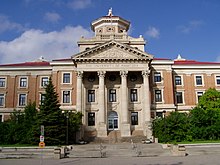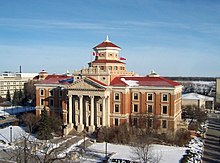University of Manitoba
| University of Manitoba | |
|---|---|

|
|
| motto | Floreat |
| founding | 1877 |
| Sponsorship | state |
| place |
Winnipeg , Manitoba , Canada |
| President and Vice-Chancellor | David T. Barnard |
| Students | approx. 27,700 |
| Employee | approx 4500 |
| Networks | U15 , CARL , IAU , UArktis |
| Website | www.umanitoba.ca |
The University of Manitoba ( UM ) was founded in 1877 by the three colleges St. Boniface College , St. John's College and Manitoba College in order to be able to award university degrees to the students there. The UM was the first university to be established in Western Canada . She is a member of the University of the Arctic .
history
The Manitoba Parliament in 1900 amended the University Act to allow UM independence. In 1904 the first teaching building was erected in the city of Winnipeg . UM started with six professors, all of them from the field of science .
After further study programs and teaching buildings were added, the UM changed its permanent seat to Fort Garry in 1929 .
Since its inception, UM has incorporated a number of colleges into its cooperative and content-based corporation. Manitoba Medical College was admitted in 1882, followed by:
- Methodist Church's Wesley College in 1888
- Manitoba College of Pharmacy 1902
- Manitoba Agriculture College 1906
- St. Paul's College 1931
- Brandon College 1938
- St. Andrew's College 1981 ( founded to teach the priesthood of the Greek Orthodox Church )
The two schools, the Canadian Mennonite Bible College in Tuxedo , and the Canadian Nazarene College in Fort Garry, were recognized as recognized universities by the UM. In 1967 the state government of Manitoba gave the UM schools the status of "University".
The first was United College ( created from a merger of the two schools Wesley College and Manitoba College ), which became the University of Winnipeg . Second, Brandon College became Brandon University .
St. Boniface College and St. John's College, both founding schools of the university, are still members of the UM.
St. Boniface College, a Roman Catholic institution whose roots date back to 1818, is the UM cooperative's only French-speaking school. It offers courses that are either held in French or courses for teaching staff who later want to give their own courses in French.
St. John's College, whose history dates back to 1820, has emphasized the arts and sciences. In addition to other special studies, it prepares students for the priesthood of the Anglican Church .
today
There are the following colleges:
- Collège universitaire de Saint-Boniface (University College of St. Boniface)
- St. John's College
- St. Paul's College
- St. Andrew's College
- University College
There are 22 departments in which bachelor, master and doctoral degrees can be achieved:
- Agricultural and Food Sciences
- School of Agriculture
- Architecture
- School of Art
- Faculty of Arts
- Clayton H. Riddell Faculty of Environment, Earth, and Resources
- Faculty of Dentistry
- School of Dental Hygiene
- Faculty of Education
- Faculty of Engineering - Students can choose one of the following specializations: Biosystems Engineering, Civil Engineering, Computer Engineering, Electrical Engineering, Manufacturing Engineering, and Mechanical Engineering
- Extended Education
- Faculty of Human Ecology
- IH Asper School of Business
- Faculty of Law
- Marcel A. Desautels Faculty of Music
- School of Medical Rehabilitation
- Faculty of Medicine
- Faculty of Nursing
- Faculty of Pharmacy
- Faculty of Kinesiology & Recreation Management
- Faculty of Science
- Faculty of Social Work
- Division of Extended Education
33 of the buildings on the UM campus of Fort Garry are mainly used as teaching buildings.
Four of these houses the following schools
- St. John's College
- St. Paul's College
- St. Andrew's College
- University College
The remaining buildings are used for laboratories, offices, dormitories and administrative offices.
The second university campus includes a complex of nine buildings in the center of Winnipeg. They house the university's medical and dental departments.
UM has a staff of 2,348 and approximately 27,000 enrolled students. ( As of 2008 )
Well-known graduates
- Patricia Churchland (* 1943), Canadian philosopher
- Frederick Philip Grove (1879–1948), German-Canadian writer and translator
- Norman Cantor (1929-2004), American historian
- Judith Evelyn (1909–1967), American actress
- Phil Fontaine (* 1944), Indian tribal leader
- Marshall McLuhan (1911–1980), communications and literary scholar
- Bruce Flatt , CEO of Brookfield Asset Management
- Eric Wright (1929–2015), Canadian writer and university professor of English origin
- Bryan Joseph Bayda (born 1961), Canadian Bishop of Saskatoon
- Stephen Soroka (* 1951), Archbishop of Philadelphia
Web links
Footnotes
Coordinates: 49 ° 48 '33.9 " N , 97 ° 7' 57.9" W.



